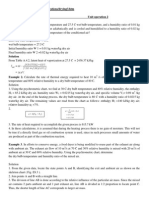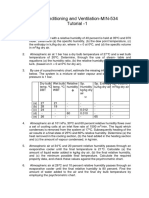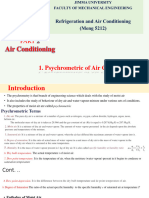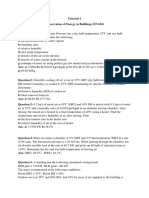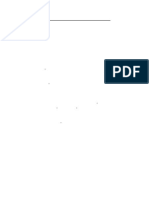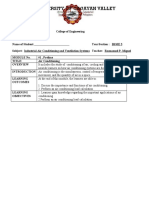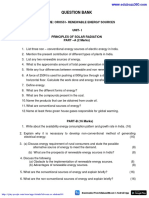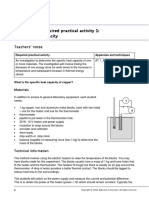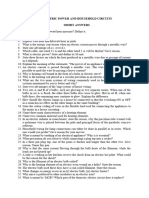Unit V
Unit V
Uploaded by
Nallappan Rajj ACopyright:
Available Formats
Unit V
Unit V
Uploaded by
Nallappan Rajj AOriginal Title
Copyright
Available Formats
Share this document
Did you find this document useful?
Is this content inappropriate?
Copyright:
Available Formats
Unit V
Unit V
Uploaded by
Nallappan Rajj ACopyright:
Available Formats
MAHENDRA INSTITUTE OF TECHNOLOGY
Mahendhirapuri
Department Of Mechanical Engineering
of saturation v) dew point temperature and vi) enthalpy of the mixture. 7. 1 kg of air at 313K dry bulb temperature and 50% relative humidity is mixed with 2kg air at 293K dry bulb temperature and 203K dew point temperature. Calculate the temperature and specific humidity of the mixture. 8. Describe the adiabatic cooling process and deduce the expression for its enthalpy. 9. A steam of air at 101.32KPa, 18C, and a relative humidity of 30% is flowing at the rate of 14.15m3/min. A second stream at 101.32KPa, 38C and a relative humidity of 50% is flowing at the rate of 8.5m3/min. The two streams are mixed adiabatically to form a third stream at 101.31KPa. Determine the specific humidity, relative humidity and the dry bulb temperature of the third stream. 10. Atmospheric air at 1.0132bar has DBT of 32C and a WBT of 26C. Compute i) partial pressure of water vapour ii) specific humidity iii) dew point temperature iv) relative humidity v) degree of saturation vi) density of air in the mixture vii) density of vapour in the mixture and viii) enthalpy of the mixture. Use thermodynamic table only. 11. Explain the process of cooling dehumidification of air. 12. 30m3/min of moist air at 15C DBT and 13C WBT are mixed with 12m3/min of moist air at 25C DBT and 18C WBT. Determine DBT and WBT of the mixture assuming the barometric pressure is one atmosphere. 13. What is the lowest temperature that air can attain in an evaporative cooler, if it enters at 1 atm, 302K and 40 percent relative humidity?
UNIT-V (PSYCHROMETRY) 1. Air at 16C and 25% relative humidity passes through a heater and then through a humidifier to reach final dry bulb temperature of 30C and 50% relative humidity. Calculate the heat and moisture added to the air. What is the sensible heat factor? 2. In an adiabatic mixing of two streams, derive the relationship among the ratio of mass of streams, ratio of enthalpy change and ratio of specific humidity change. 3.Saturated air at 20C at a rate of 1.167m3/s is mixed adiabatically with the outside air at 35C and 50% relative humidity at a rate of 0.5m3/s. Assuming adiabatic mixing condition at 1 atm, determine specific humidity, relative humidity, dry bulb temperature and volume flow rate of the mixture. 4. A room 7m x 4m x 4m is occupied by an air water vapour mixture at 38C. The atmospheric pressure is 1bar and the relative humidity is 70%. Determine humidity ratio, DPT, mass of dry air and mass of water vapour. If the mixture of air-water vapour is further cooled at constant pressure until the temperature is 10C. Find the amount of water vapour condensed. 5. Air at 20C, 40% RH is mixed adiabatically with air at 40C, 40%RH in the ratio of 1kg of the former with 2kg of later. Find the final condition (humidity & enthalpy) of air. Draw the process in chart also as diagram. 6. In a laboratory test, a sling psychrometer recorded dry bulb and wet bulb temperatures as 303K and 298K respectively. Calculate i) vapour pressure ii) relative humidity iii) specific humidity iv) degree
14. Consider a room that contains air at 1 atm, 308K and 40 percent relative humidity. Using the Psychrometric chart, determine: the specific humidity, the enthalpy, the wet-bulb temperature, the dew point temperature and the specific volume of the air. 15. An air-conditioning system is to make in outdoor air at 283K and 30percent relative humidity at a steady rate of 45m3/min and to condition it to 298K and 60percent relative humidity. The outdoor air is first heated to 295K in the heating section and then humidified by the injection of hot steam in the humidifying section. Assuming the entire process takes place at a pressure of 100KPa, determine i) the rate of heat supply in the heating section and ii) the mass flow rate of the steam required in the humidifying section. 16. A 5m x 5m x 3m room contains air at 25C and 100KPa at a relative humidity of 75 percent. Determine i) The partial pressure of dry air ii) The specific humidity iii) The enthalpy per unit mass of the dry air, and iv) The masses of the dry air and water vapour in the room. 17. The dry and the wet-bulb temperatures of atmospheric air at 1 atm (101.325KPa) pressure are measured with a sling psychrometer and determined to be 25C and 15C respectively. Determine i) The specific humidity ii) The relative humidity, and iii) The enthalpy of the air using thermodynamic relations. 18. What is sensible heat? How is the sensible heat loss from a human body affected by the i) skin temperature ii) environment temperature and iii) air motion. 19. Saturated air leaving the cooling section of an air-conditioning system at 14C at a rate of 50m3/min is mixed adiabatically with the outside air at 32C and 60 percent relative humidity at rate of 20m3/min. Assuming that the mixing process occurs at a pressure of 1 atm, determine the specific humidity, the relative humidity, the dry bulb temperature, and the volume flow rate of mixture.
20. With the aid of suitable diagram discuss the sensible heating processes. 21. Consider a room that contains air at 1 atm, 35C and 40 percent relative humidity. Using psychometric chart, determine i) The specific humidity, ii) The enthalpy iii) The wet-bulb temperature iv) The dew-point temperature and v) Specific volume of air. 22. Why does the enthalpy of an air-vapour mixture remain constant during an adiabatic saturation process? 23. Explain the process of heating with humidification of air, with the help of sketches of schematic of air duct with the elements involved as well as the representation on Psychometric chart. 24. 1kg of air at 40C DBT and 50% RH is mixed with 2kg of air at 20C DBT and 20C dew point temperature. Calculate the specific humidity, enthalpy and the dry bulb temperature of the mixture. 25. A Sling Psychrometer reads 40C DBT and 36CWBT. Find the humidity ratio, relative humidity, dew point temperature, specific volume and enthalpy of air. 26. Explain the process of cooling dehumidification of air.
You might also like
- 91 Club HackDocument2 pages91 Club Hackbotplay301087% (47)
- Psychrometrics ProblemsDocument10 pagesPsychrometrics ProblemsManish MahadevwalaNo ratings yet
- Tutorial PsychrometryDocument2 pagesTutorial PsychrometryKaran Kumawat0% (2)
- Worksheet 1Document2 pagesWorksheet 1Ali SeidNo ratings yet
- SH - No.1 ACDocument3 pagesSH - No.1 ACيوسف عبيد خليفةNo ratings yet
- Problems 1 0100103304 2-59Document1 pageProblems 1 0100103304 2-59Jj LewandyNo ratings yet
- Sheet #9 (Moist Air)Document1 pageSheet #9 (Moist Air)sarahamdyelsadekNo ratings yet
- Thermo 3 Tute 2Document1 pageThermo 3 Tute 2jcdmjdmcrNo ratings yet
- Homework Ii: Gem 447E Ventilation and Air-Conditioning Systems For ShipsDocument2 pagesHomework Ii: Gem 447E Ventilation and Air-Conditioning Systems For ShipsIzzah HzmhNo ratings yet
- Acond Tut PDFDocument0 pagesAcond Tut PDFizzudinrozNo ratings yet
- Internal II Question Paper Etd Set IIDocument2 pagesInternal II Question Paper Etd Set IItagoreboopathyNo ratings yet
- AIRCONDITIONING ProblemsDocument28 pagesAIRCONDITIONING Problemsعبدالرحمن منصورNo ratings yet
- Psychrometry ProblemsDocument33 pagesPsychrometry Problems19R21A0334 MATTA SHASHANKNo ratings yet
- RacDocument2 pagesRaceswaran4812lNo ratings yet
- Properties of Moist AirDocument2 pagesProperties of Moist AirKenneth ManuelNo ratings yet
- MIN-534 Tut 1Document2 pagesMIN-534 Tut 1ABHIRAM K BNo ratings yet
- Gas MixDocument2 pagesGas MixLena BshnaweNo ratings yet
- Practice Problems On Air Conditioning SystemDocument1 pagePractice Problems On Air Conditioning Systemsushil.vgiNo ratings yet
- MEC551 Tutorial 5 (Aircondition)Document2 pagesMEC551 Tutorial 5 (Aircondition)Imhaziq ZamriNo ratings yet
- An AirDocument2 pagesAn AirAlbert Junior EvangelistaNo ratings yet
- Tut 5Document1 pageTut 5me21b105No ratings yet
- Tutorial 1 - HumidificationDocument2 pagesTutorial 1 - HumidificationwafinNo ratings yet
- Etd 2mechDocument2 pagesEtd 2mechgsudhanta1604No ratings yet
- Psych ExercisDocument2 pagesPsych ExercisJohn Jonel CasupananNo ratings yet
- AIRCON - Problem Set 2 - ReviewDocument1 pageAIRCON - Problem Set 2 - ReviewBenedict LucilaNo ratings yet
- Psych Rome TryDocument2 pagesPsych Rome TryAaditya VijayNo ratings yet
- Acvs Problems Topic 1 N 2Document1 pageAcvs Problems Topic 1 N 2poadNo ratings yet
- Short Answer QuestionsDocument7 pagesShort Answer Questionsvenky437No ratings yet
- Chapter-1: Constituent PercentageDocument7 pagesChapter-1: Constituent PercentageAnteneh TarikuNo ratings yet
- Q13&14Document2 pagesQ13&14Dhenil ManubatNo ratings yet
- Q13&14Document2 pagesQ13&14Duaa GadoraaNo ratings yet
- Q13&14Document2 pagesQ13&14Izzah HzmhNo ratings yet
- PsychrometryDocument5 pagesPsychrometryralona2648No ratings yet
- AC Problems-1Document1 pageAC Problems-1SjsinssjNo ratings yet
- Me2202 Engineering Thermodynamics - Uq - Nov Dec 2010Document4 pagesMe2202 Engineering Thermodynamics - Uq - Nov Dec 2010BIBIN CHIDAMBARANATHANNo ratings yet
- ME321 Assignment 4 PDFDocument1 pageME321 Assignment 4 PDFPallav AgrawalNo ratings yet
- Psych Ro MetricDocument11 pagesPsych Ro MetricLucia Kara Chance100% (1)
- Department of Mechanical EngineeringDocument3 pagesDepartment of Mechanical EngineeringJames Patrick TorresNo ratings yet
- Problem Set - MidtermDocument3 pagesProblem Set - MidtermJohn Paul JacalanNo ratings yet
- CL 321-Assignment No.3Document1 pageCL 321-Assignment No.3Pinjala AnoopNo ratings yet
- HW-6, Ch-14Document9 pagesHW-6, Ch-14Natalie NinachuuNo ratings yet
- Week 4 Selft StudyDocument2 pagesWeek 4 Selft Study2024568653No ratings yet
- Air ConditioningDocument37 pagesAir ConditioningEphraim MekonnenNo ratings yet
- Air ConditioningDocument72 pagesAir ConditioningNIKNo ratings yet
- Abhyas 2Document19 pagesAbhyas 2Vikram Kumar0035 MENo ratings yet
- TD QP UPTO Nov 2012 18092012Document31 pagesTD QP UPTO Nov 2012 18092012Narayanan Srinivasan100% (1)
- 18me3114 AcsdDocument7 pages18me3114 AcsdMukesh ReddyNo ratings yet
- Energy Conservation in BuildingsDocument2 pagesEnergy Conservation in BuildingsAlex MarkNo ratings yet
- RAC Assignment SolnDocument13 pagesRAC Assignment SolnyashwantkrmhtoNo ratings yet
- Tutorial 6 Mixtures BDA 3043 - Thermodynamics II Winardi SaniDocument3 pagesTutorial 6 Mixtures BDA 3043 - Thermodynamics II Winardi SaniwanpudinNo ratings yet
- Cooling TowersDocument2 pagesCooling TowersFrancis DacutananNo ratings yet
- 1.mODULE # 1. Indl Air Cond'ng .PRELIMSDocument15 pages1.mODULE # 1. Indl Air Cond'ng .PRELIMSEmmanuel MiguelNo ratings yet
- A Modern Course in Statistical PhysicsFrom EverandA Modern Course in Statistical PhysicsRating: 3.5 out of 5 stars3.5/5 (2)
- Heat and Moisture Transfer between Human Body and EnvironmentFrom EverandHeat and Moisture Transfer between Human Body and EnvironmentNo ratings yet
- Me8072 Renewable Sources of EnergyDocument13 pagesMe8072 Renewable Sources of EnergyNallappan Rajj ANo ratings yet
- பகுதி ஆ இலக்கியம் முழுவதும்Document330 pagesபகுதி ஆ இலக்கியம் முழுவதும்PreethiNo ratings yet
- All Elding TechniqueDocument9 pagesAll Elding TechniqueNallappan Rajj ANo ratings yet
- ORO551 Renewable Energy Sources QB 2Document7 pagesORO551 Renewable Energy Sources QB 2Nallappan Rajj ANo ratings yet
- Explosive WeldingDocument54 pagesExplosive WeldingNallappan Rajj ANo ratings yet
- Diffusion BondingDocument16 pagesDiffusion BondingNallappan Rajj ANo ratings yet
- ORO551 Renewable Energy Sources QB 3Document2 pagesORO551 Renewable Energy Sources QB 3Nallappan Rajj ANo ratings yet
- Resistance WeldingDocument68 pagesResistance WeldingNallappan Rajj ANo ratings yet
- Friction WeldingDocument20 pagesFriction WeldingNallappan Rajj ANo ratings yet
- Intro To NDTDocument39 pagesIntro To NDTNallappan Rajj ANo ratings yet
- Friction Stir WeldingDocument23 pagesFriction Stir WeldingNallappan Rajj ANo ratings yet
- MECH-ND-2020-ME 6701-Power Plant Engineering-492863724 - (ME6701) POWER PLANT ENGINEERINGDocument2 pagesMECH-ND-2020-ME 6701-Power Plant Engineering-492863724 - (ME6701) POWER PLANT ENGINEERINGNallappan Rajj ANo ratings yet
- Special WeldingDocument20 pagesSpecial WeldingNallappan Rajj ANo ratings yet
- EMM NoteCLASS NOTESsDocument61 pagesEMM NoteCLASS NOTESsNallappan Rajj ANo ratings yet
- Stucor Me8792 BH UnlockedDocument31 pagesStucor Me8792 BH UnlockedNallappan Rajj ANo ratings yet
- Vsa Project Format ADocument1 pageVsa Project Format ANallappan Rajj ANo ratings yet
- Vsa Project Format BDocument2 pagesVsa Project Format BNallappan Rajj ANo ratings yet
- 06 09 2015 Civil Engineering PDFDocument79 pages06 09 2015 Civil Engineering PDFNallappan Rajj ANo ratings yet
- Me2203 PDFDocument31 pagesMe2203 PDFNallappan Rajj ANo ratings yet
- Metrology Lab Manual CovaiDocument51 pagesMetrology Lab Manual CovaiNallappan Rajj ANo ratings yet
- Engineering Materials and Metallurgy Notes PDFDocument0 pagesEngineering Materials and Metallurgy Notes PDFSenthilkumar Subbiah50% (2)
- Strength of Materials For RTO MAIN EXAM - Llc6suihiesnobmayomuDocument53 pagesStrength of Materials For RTO MAIN EXAM - Llc6suihiesnobmayomuAshwini SidralNo ratings yet
- Physics Note 3Document1 pagePhysics Note 3promisefunsho426No ratings yet
- Look-Up High: Thermo FlowDocument11 pagesLook-Up High: Thermo Flowrenzo andradeNo ratings yet
- Akash Physics (12th) CPP 6Document25 pagesAkash Physics (12th) CPP 6yashrajhere121No ratings yet
- HCHEM Notes Specific Heat Capacity 3 2Document21 pagesHCHEM Notes Specific Heat Capacity 3 2leimendozaschoolNo ratings yet
- F-Mech Prop 2006 09 25 ENDocument39 pagesF-Mech Prop 2006 09 25 ENPartho ChoudhuryNo ratings yet
- Name: Teacher: Date: Score:: Double Line Graph ComprehensionDocument2 pagesName: Teacher: Date: Score:: Double Line Graph ComprehensionAnabbNo ratings yet
- 02 - Property Tables and ChartsDocument2 pages02 - Property Tables and ChartsjhamilcarNo ratings yet
- EdExcel A Level Physics Topic 2 MechanicsDocument105 pagesEdExcel A Level Physics Topic 2 Mechanicssunil1212No ratings yet
- Lec - 5 - Mohrs CircleDocument56 pagesLec - 5 - Mohrs Circlehurairabaig37No ratings yet
- Dpcs St0250 Unit-1 Chapter-3Document50 pagesDpcs St0250 Unit-1 Chapter-3Ibrahim ShaikhNo ratings yet
- Chap-3 (Motion in One Dimension) Exercise and Answer KeyDocument24 pagesChap-3 (Motion in One Dimension) Exercise and Answer Keygg4datyde123No ratings yet
- Angular Momentum Homework SolutionDocument4 pagesAngular Momentum Homework Solutionkctwfxfng100% (1)
- Lab 3Document5 pagesLab 3Oliver RajNo ratings yet
- QI 003 Dial GaugeDocument13 pagesQI 003 Dial Gaugeipkm123No ratings yet
- Work Power Energy - JEE Main 2024 January Question Bank - MathonGoDocument4 pagesWork Power Energy - JEE Main 2024 January Question Bank - MathonGoHarmehar KaurNo ratings yet
- Heat Capacity PracticalDocument6 pagesHeat Capacity PracticalAIRUNINo ratings yet
- 11 Chapter 11 Solution Thermodynamics - Theory - ModifiedDocument56 pages11 Chapter 11 Solution Thermodynamics - Theory - ModifiedEng Mohammed100% (1)
- Module 5 No AkDocument14 pagesModule 5 No AkMargareth RiveraNo ratings yet
- Physics g12 ModelDocument10 pagesPhysics g12 Modelmusaabee3918No ratings yet
- Flanged Bolt Couplings and SpringDocument14 pagesFlanged Bolt Couplings and SpringJRovick M.No ratings yet
- Electric Power and Household CircuitsDocument7 pagesElectric Power and Household CircuitsHARSH KUMAR SINGHNo ratings yet
- Nalayag Visitor Center PVSYS JKM260 - SM200-2pcs - MS45amp - 1kWp Off GridDocument5 pagesNalayag Visitor Center PVSYS JKM260 - SM200-2pcs - MS45amp - 1kWp Off GridJimmy AsuncionNo ratings yet
- Steel Beam NSCP 2001 & 2 015 AnalysisDocument19 pagesSteel Beam NSCP 2001 & 2 015 AnalysisDreamzzz GamingNo ratings yet
- 11th Class Physics Mqs Guess PaperDocument14 pages11th Class Physics Mqs Guess Paperkim427410No ratings yet
- Sri Chaitanya PhysicsDocument2,260 pagesSri Chaitanya PhysicsSudhir Kumar YadavNo ratings yet
- 49 10 02Document15 pages49 10 02Ulrich HübnerNo ratings yet
- Rock Mechanics and Rock EngineeringDocument69 pagesRock Mechanics and Rock EngineeringNicole CalilNo ratings yet
- Memorial de Calculo Rev01Document6 pagesMemorial de Calculo Rev01Oleoplan NordesteNo ratings yet

